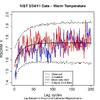Boulder Group
The Boulder Statistics Group in the Statistical Engineering Division focuses on collaborations with NIST scientists in the Boulder, Colorado, campus.
The Boulder Statistics Group focuses on collaborations with NIST scientists in the Boulder, Colorado, campus, and with scientists in external institutions in the Boulder, Fort Collins, and Denver areas. The NIST collaborations emphasize applications of statistical methods in the physical sciences, including communications technology, electromagnetics, and neutron physics, and in the materials sciences, including reliability and related standard reference materials. The Group also conducts research in statistical methods for the assessment of measurement uncertainty, and for the combination of measurements in interlaboratory studies.




